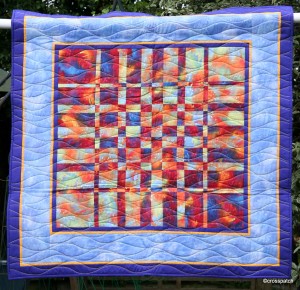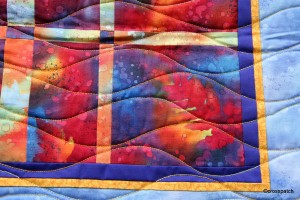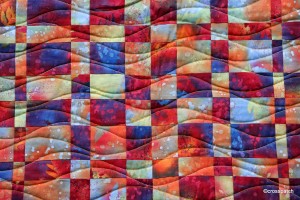Inspired by the wonderful work of Ricky Tims, based on the Mathematical theorem of Fibonacci, I was inspired to have a stab at one of Ricky’s quilts; the first attempt was for a gift, a cot quilt for a friend who was expecting her first child. I was so pleased with it when it was finished it, that I could hardly bear to part with it, but still, it was made for Eric, and so to Eric it was given. Eric now prefers aeroplanes, so it lives in his parent’s room, hanging on the wall. Can’t argue with that!

This is my second attempt, in Fossil Fern fabrics. I have to say with this particular design, accuracy is all. Many people will tell you they are not members of the Quilt Police and it’s OK if your points don’t meet. I am a paid up member of the Quilt Police, points have to come to a point, seams need to meet where they are supposed to meet, and I will unpick and try again, once, even twice, but after that I will embrace imperfection and move on; life is too short, and only God is perfect. I can be relaxed about points and joins in some Quilt patterns but if you are working to a pattern, inspired by a 13th Century mathematician, then surely to goodness, accuracy is absolutely the point. (Fibonacci’s 1202 book Liber Abaci introduced the Fibonacci sequence to Western European mathematics).

Look closely at my joins, I did my absolute best to make sure every point and join met as neatly as I could, mostly that was achieved by careful planning and pressing of seams to make sure every seam butted neatly with the next.
It looks very complex to achieve but actually, provided you give it your full and undivided attention, it’s very simple to make, take 4 equal size squares of fabric, stitch two together,then the other two and laying them side by side you simply cut each strip incrementally larger from the centre to the edge and then interleave the narrowest strip from one pair with the widest from the opposite edge of the other pair, and so on till the centre strips are of equal width, stitch together, press, turn by 90 degrees and do it again.
I do mean full and undivided attention, don’t have the TV on in the background, don’t be talking to a friend, don’t be singing along to the radio, and for goodness sake don’t be stewing about a row you’ve had, or some other cause for irritation, that way disaster lies. You need to be in a Zen like state of calm concentration when cutting each strip, as any mistake is very difficult to retrieve.
If you want better instructions, it’s a Ricky Tims’ quilt design, I recommend you check out his website (see below) and consider buying one of his books on the subject, where he gives excellent guidance and many more interesting projects.

